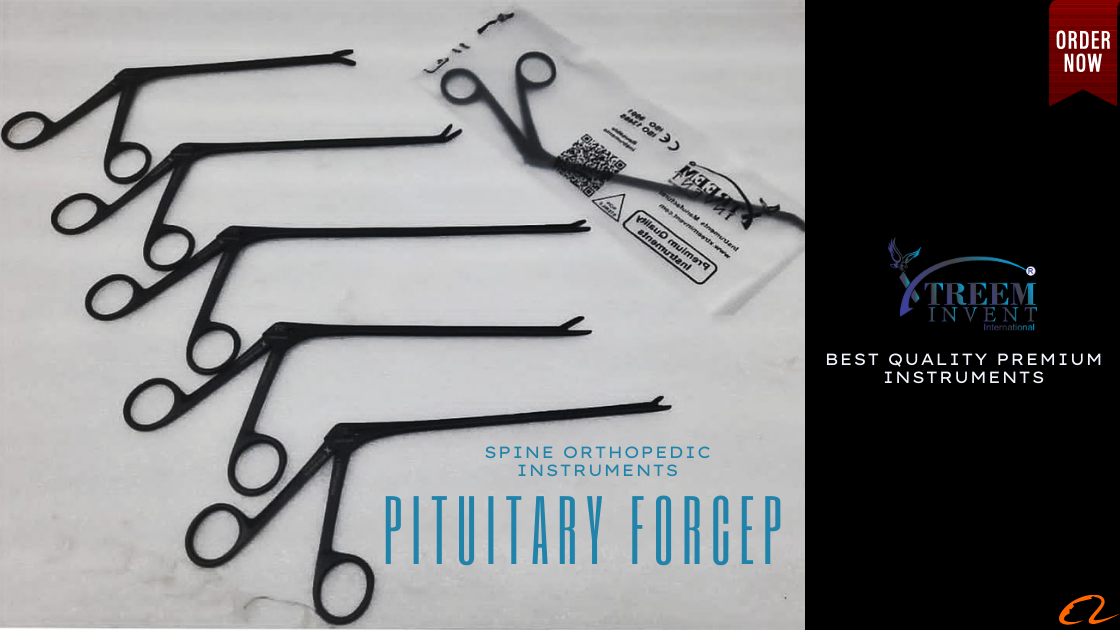Blog
Understanding Pituitary Forceps: Essential Tool for Neurosurgery and Spine Surgery

Pituitary forceps are critical instruments in the field of neurosurgery and spine surgery, known for their precision and reliability in delicate tissue manipulation. These forceps are indispensable for surgeons, allowing them to perform intricate procedures with accuracy and control. In this blog, we’ll explore the design, functionality, and applications of pituitary forceps, and why they are a must-have in any surgical toolkit.
BUY NOW ON OUR ALIBABA STORE:
What Are Pituitary Forceps?
Pituitary forceps are specialized surgical instruments used primarily in neurosurgery, particularly for procedures involving the brain, spinal cord, and surrounding structures. Named after the pituitary gland, these forceps were originally designed for operations involving this vital gland. However, their utility has since expanded to a wide range of surgical procedures, especially those requiring the precise removal of soft tissues, small bone fragments, or intervertebral disc material.
Design and Features
Pituitary forceps are characterized by their slender, elongated design, which allows for easy access to deep and confined surgical sites. Here are some of the key features that make these forceps essential in surgery:
1. Long, Slim Shaft
- The long, slim shaft of pituitary forceps is designed to reach deep into the body without causing significant disruption to surrounding tissues. This is particularly important in spinal and brain surgeries, where precision is paramount.
2. Curved or Straight Tips
- The forceps come with either curved or straight tips, each serving specific surgical needs. Curved tips are often used to navigate around sensitive structures, while straight tips provide direct access to target tissues.
3. Serrated or Smooth Jaws
- Pituitary forceps are equipped with either serrated or smooth jaws. Serrated jaws provide a firm grip on tissue or bone fragments, ensuring they do not slip during removal. Smooth jaws are used for more delicate tasks where minimal trauma to tissues is required.
4. Ergonomic Handle
- The handle of the pituitary forceps is designed for comfortable and secure use, allowing surgeons to maintain control during lengthy procedures. The ergonomic design reduces hand fatigue, which is crucial during complex surgeries.
Applications of Pituitary Forceps
Pituitary forceps are versatile tools used in a variety of surgical procedures. Here are some of the most common applications:
1. Neurosurgery
- In neurosurgery, pituitary forceps are used for the precise removal of tumors, cysts, or other lesions in the brain. Their ability to access deep areas with minimal disruption makes them invaluable for delicate operations near vital structures.
2. Spinal Surgery
- During spinal surgeries, pituitary forceps are often employed to remove intervertebral disc material, bone fragments, or other tissues that may be compressing the spinal cord or nerves. Their slim design and strong grip make them ideal for working in the confined spaces of the spine.
3. ENT (Ear, Nose, Throat) Surgery
- Pituitary forceps are also used in certain ENT surgeries, such as the removal of nasal polyps or other soft tissue masses. Their precision and ability to work in narrow spaces make them suitable for these procedures.
Why Choose Pituitary Forceps?
When it comes to selecting surgical instruments, the quality and design of pituitary forceps make a significant difference in surgical outcomes. Here’s why these forceps are a preferred choice for surgeons:
1. Precision and Control
- The design of pituitary forceps ensures that surgeons can operate with the highest level of precision, making them ideal for delicate procedures where accuracy is critical.
2. Versatility
- Pituitary forceps are not limited to one type of surgery; they are versatile tools that can be used in various surgical disciplines, from neurosurgery to ENT procedures.
3. Durability
- High-quality pituitary forceps are made from durable stainless steel, ensuring they withstand the rigors of repeated sterilization and use without compromising performance.
Sizes and Angles of Pituitary Forceps: Tailored for Precision in Surgery
These forceps are meticulously designed to meet the specific needs of surgeons during delicate procedures. The sizes and angles of these forceps play a crucial role in their effectiveness, allowing for precise manipulation of tissues in confined and sensitive areas. Here’s a closer look at the different sizes and angles available for pituitary forceps, and how they contribute to their functionality.
Sizes of Pituitary Forceps
Pituitary forceps come in a range of sizes to accommodate various surgical needs, from deep-seated brain operations to spinal and ENT procedures. The size of a this forcep typically refers to the length of the instrument, as well as the width of the jaws.
1. Lengths
- Short (4-6 inches): These forceps are ideal for procedures requiring fine, detailed work in more accessible areas. They offer surgeons greater control and are often used in delicate brain or ENT surgeries.
- Medium (7-9 inches): Medium-length forceps provide a balance between reach and control, making them suitable for a wide range of procedures, including spinal surgery and deeper brain operations.
- Long (10-12 inches or more): Longer forceps are used for accessing deep and narrow surgical sites, such as during spinal surgery or when reaching into the cranial cavity. They allow surgeons to work in confined spaces without compromising precision.
2. Jaw Width
- Narrow (1-2 mm): Narrow jaws are designed for extremely delicate work, allowing for precise removal of small tissue fragments or bone pieces. These are often used in neurosurgery where fine control is paramount.
- Wide (3-5 mm or more): Wider jaws are used when a larger tissue mass needs to be removed or when a stronger grip is required, such as in certain spinal procedures.
Angles of Pituitary Forceps
The angle of the pituitary forceps refers to the curvature of the instrument’s tip. This feature is crucial for accessing difficult-to-reach areas while minimizing damage to surrounding tissues.
1. Straight Forceps
- Description: Straight pituitary forceps have no curvature and are used when a direct approach to the tissue is possible.
- Application: Ideal for procedures where the surgeon has a clear and direct line of sight to the target tissue, such as certain spinal operations or accessible brain surgeries.
2. Curved Forceps
- Description: These forceps have a curved tip, which can vary in degree from slight to significant curvature.
- Applications:
- Slightly Curved: Useful for gently navigating around anatomical structures or when a slight angle is needed to reach the target tissue.
- Moderately Curved: Allows for access to tissues that are obstructed by other anatomical features, such as bones or other organs. Commonly used in surgeries where indirect access is necessary, like deep brain or spinal procedures.
- Heavily Curved: Designed for reaching around sharp angles or into confined spaces, these forceps are indispensable in complex surgeries where direct access is not feasible.
Why Sizes and Angles Matter
The variety in sizes and angles of pituitary forceps allows surgeons to select the most appropriate instrument for each specific task. Whether it’s navigating through narrow corridors of the spine or performing delicate maneuvers within the brain, the right size and angle ensure that the surgeon can operate with the highest level of precision and control.
Choosing the Right Pituitary Forceps
Selecting the appropriate size and angle of pituitary forceps is critical for achieving optimal surgical outcomes. Surgeons should consider the specific needs of the procedure, including the depth of the surgical site, the type of tissue being manipulated, and the surrounding anatomical structures.
At Xtreem Invent Instruments, we offer a wide range of pituitary forceps designed to meet the exacting standards of modern surgery. Our instruments are crafted with precision and available in various sizes and angles to ensure that you have the right tool for every procedure. Explore our catalog today and equip your surgical team with the instruments they need for success.
Material Options for Pituitary Forceps
Pituitary forceps are critical instruments in delicate surgeries, and the material from which they are made plays a significant role in their performance, durability, and overall effectiveness. Here’s an overview of the most common material options used in the manufacturing of pituitary forceps:
1. Stainless Steel
- Description: Stainless steel is the most common material used for surgical instruments, including pituitary forceps. It is known for its strength, durability, and resistance to corrosion.
- Benefits:
- Corrosion Resistance: Stainless steel is highly resistant to rust and corrosion, which is essential for instruments that are repeatedly sterilized.
- Strength and Durability: It provides the necessary strength to handle the force required during surgery without deforming or breaking.
- Biocompatibility: Stainless steel is biocompatible, meaning it is safe for use in the human body without causing adverse reactions.
- Ease of Maintenance: It is easy to clean, sterilize, and maintain, ensuring long-term usability.
- Common Types:
- AISI 420: Often used for cutting instruments, known for its hardness and sharpness.
- AISI 316L: Used for instruments requiring high corrosion resistance, especially in environments with frequent exposure to saline or other corrosive agents.
2. Titanium
- Description: Titanium is a high-performance metal that is increasingly used for surgical instruments due to its unique properties.
- Benefits:
- Lightweight: Titanium is significantly lighter than stainless steel, reducing surgeon fatigue during lengthy procedures.
- Strength and Flexibility: Despite its lightness, titanium is extremely strong and offers a degree of flexibility, which can be beneficial in certain surgical applications.
- Corrosion Resistance: Titanium is even more resistant to corrosion than stainless steel, particularly in harsh environments or when exposed to bodily fluids.
- Biocompatibility: Titanium is highly biocompatible and often used in implants, making it safe for surgical use.
- Drawbacks:
- Cost: Titanium instruments are more expensive than stainless steel ones, due to the cost of the material and the complexity of the manufacturing process.
- Maintenance: While highly durable, titanium requires careful handling to avoid surface scratches that could compromise its corrosion resistance.
3. Tungsten Carbide
- Description: Tungsten carbide is used in the tips or cutting edges of some pituitary forceps, often combined with a stainless steel body.
- Benefits:
- Extreme Hardness: Tungsten carbide is one of the hardest known materials, offering a sharp and durable cutting edge that remains sharp longer than steel alone.
- Wear Resistance: It provides superior wear resistance, making the forceps ideal for high-use situations.
- Precision: The hardness of tungsten carbide allows for extremely precise manipulation and cutting.
- Drawbacks:
- Cost: Instruments with tungsten carbide tips are more expensive due to the material’s high cost and the additional manufacturing steps required.
- Brittleness: Tungsten carbide, while hard, is also brittle and can chip or crack if mishandled.
4. Plastic-Coated Stainless Steel
- Description: Some pituitary forceps feature stainless steel bodies with plastic coatings on the handles to improve ergonomics and grip.
- Benefits:
- Enhanced Grip: The plastic coating provides a better grip, especially in a wet surgical environment.
- Insulation: Plastic can offer insulation, which may be beneficial in certain procedures to prevent the conduction of electricity if the forceps come into contact with an electrosurgical device.
- Drawbacks:
- Durability of Coating: The plastic coating can wear off over time, especially with repeated sterilization and use.
Choosing the Right Material
The choice of material for pituitary forceps depends on the specific needs of the surgical procedure, the surgeon’s preferences, and budget considerations. Stainless steel is the most common and cost-effective option, offering a balance of strength, durability, and resistance to corrosion. For those requiring lighter instruments or working in more demanding environments, titanium offers superior performance at a higher cost. Tungsten carbide-tipped forceps are ideal for procedures that demand extreme precision and sharpness.
At Xtreem Invent Instruments, we offer a range of pituitary forceps in different materials to suit every surgical need. Our instruments are crafted with the highest standards of quality to ensure optimal performance in the operating room. Explore our collection to find the perfect material and design for your surgical toolkit.
Customization Options for Pituitary Forceps
When it comes to surgical instruments like pituitary forceps, customization can make a significant difference in the comfort, precision, and effectiveness of the tools. Customization options allow surgeons to tailor the instruments to their specific needs and preferences, enhancing the overall surgical experience. Here’s a look at the various customization options available for pituitary forceps:
1. Length and Size
- Custom Length: While standard lengths are commonly available, surgeons can request custom lengths to suit specific surgical requirements. Whether you need a shorter tool for shallow procedures or an extended length for deep access, customizing the length ensures optimal reach and control.
- Jaw Size: The width of the forceps’ jaws can also be customized. Narrow jaws are ideal for fine, delicate work, while wider jaws may be necessary for grasping larger tissue sections or fragments.
2. Tip Configuration
- Curvature Angle: The angle of the curved tip can be customized to match the exact needs of the procedure. Some surgeries may require a slight curve for minimal obstruction, while others might need a more pronounced curve for navigating around complex anatomical structures.
- Straight vs. Curved Tips: Depending on the surgeon’s preference and the type of surgery, the forceps can be designed with either straight or curved tips. Custom curvature can be specified to meet unique surgical challenges.
- Serrated vs. Smooth Jaws: Customization of the jaw texture is also available. Serrated jaws provide a stronger grip, useful for holding onto slippery or tough tissues, while smooth jaws are gentler and may be preferred for delicate tissue handling.
3. Handle Design
- Ergonomics: The handle can be customized for ergonomic comfort, reducing hand fatigue during long procedures. This might include adjustments in the shape, size, or addition of finger grips.
- Coating: Handles can be coated with non-slip materials, such as silicone or other plastics, to improve grip and comfort during use. This is particularly useful in procedures where maintaining a steady hold is critical.
- Insulation: For procedures involving electrosurgical devices, handles can be insulated to prevent the conduction of electricity, ensuring the surgeon’s safety.
4. Material Choices
- Selection of Material: Surgeons can choose from various materials, including stainless steel, titanium, or tungsten carbide, depending on their preference for weight, strength, and corrosion resistance.
- Finish Options: The finish of the forceps can also be customized. Options include matte or polished finishes, which can reduce glare from operating lights or provide a smoother surface for easier cleaning.
5. Markings and Identification
- Engraving: Instruments can be customized with engraved markings, such as the surgeon’s name, the hospital’s logo, or specific measurements. This aids in easy identification and prevents mix-ups in surgical settings.
- Color Coding: Handles or other parts of the forceps can be color-coded for quick identification of different sizes, tips, or specific instruments within a surgical set.
6. Locking Mechanisms
- Custom Locks: Some procedures may benefit from forceps with a locking mechanism to hold tissue or fragments in place without constant pressure from the surgeon’s hand. The design and strength of these locks can be customized based on the intended use.
7. Special Coatings
- Anti-reflective Coating: For surgeries that require a glare-free field, forceps can be coated with an anti-reflective material.
- Non-Stick Coating: To prevent tissue from sticking to the forceps during surgery, a non-stick coating can be applied. This is particularly useful in procedures involving coagulated blood or adhesive tissues.
Benefits of Customization
Customization of pituitary forceps offers several advantages:
- Enhanced Precision: Tailoring the instrument to the surgeon’s specific needs allows for greater accuracy and control during delicate procedures.
- Improved Comfort: Customized ergonomic features reduce strain on the surgeon’s hands, especially during lengthy surgeries.
- Optimal Functionality: Custom tips, jaws, and materials ensure that the forceps perform exactly as required, improving the outcome of the procedure.
- Personalization: Engraving and color-coding help in quick identification and reduce the risk of errors in the operating room.
Conclusion
Customizing pituitary forceps ensures that surgeons have the right tools for every situation, tailored to their specific requirements. Whether you need adjustments in length, tip design, material, or handle ergonomics, customization enhances both the functionality and comfort of the instrument.
At Xtreem Invent Instruments, we offer extensive customization options to meet the unique needs of surgeons worldwide. Our expert team works closely with healthcare professionals to create instruments that match their exact specifications, ensuring the highest standards of surgical performance. Contact us today to discuss your customization needs and elevate your surgical toolkit to the next level.

